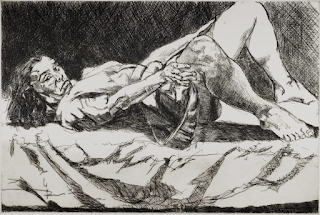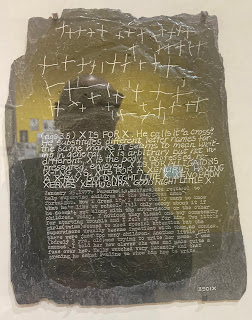Claudette Johnson: Afterbirth, 1990, pastel on paper, 118 x 83 cm
I was in Bristol recently and went to see the Acts of Creation: On Art and Motherhood exhibition at the Arnolfini. It finishes on the 26th of May, so there is little time to get to see it, but still worth I think a review as it raises several issues that are still very pertinent to contemporary art practice.
The exhibition sets out to balance our view of how motherhood has been portrayed in art, the introduction to the exhibition stating;
'While the Madonna and Child is one of the great subjects of European art, we rarely see art about motherhood as a lived experience, in all its complexity. Acts of Creation: On Art and Motherhood will address this blind spot in art history, asserting the artist mother as an important – if rarely visible – cultural figure'. Featuring the work of more than sixty modern and contemporary artists, this exhibition will approach motherhood as a creative enterprise, albeit one at times tempered by ambivalence, exhaustion or grief. Acts of Creation will explore lived experience of motherhood, offering a complex account that engages with contemporary concerns about gender, caregiving and reproductive rights. The exhibition will address diverse experiences of motherhood across three themes: Creation, which looks at conception, pregnancy, birth and nursing; Maintenance which explores motherhood and caregiving in the day-to-day; and Loss, which touches on miscarriage and involuntary childlessness, as well as reproductive rights. The heart of the exhibition is a series of revelatory self-portraits – a celebration of the artist as mother.
I went to the exhibition with my partner and one of our daughters, so it was interesting to get their opinions as well as my own drawing focused reflections.
"Has it taken all these years?" was my partner's comment, as she had worked with several of the artists on exhibition back in the 1980s and was remembering how few galleries at the time, except for the ICA, would show this type of work. A necessary rebalancing I therefore thought, but her point was that it is now all too safe and easy to show work of this sort after the event.
My focus, as usual with most exhibitions I travel to, was on the artists who use drawing. This blog is supposed to be about contemporary drawing and I have perhaps stretched the definition at times, but it still seems to make sense to have this particular focus, if for no other reason that my own art practice is drawing led.
I have put an image by Claudette Johnson at the top of this post, mainly because she is able to transcend what could be an old and tired genre, 'the life model', and turn it back into what it should always be about, an honest confrontation with a naked, human being. The drawing 'Afterbirth' is a straightforward drawing, using pastel to communicate the softness, but also strength of a woman's body. She is proud of what she has achieved and looks us directly in the face and makes no apologies for presenting herself 'afterbirth'. I really liked this drawing, as it seemed to me to involve very little artifice, 'what you see is what you get' and what you get is a mature woman, who is happy to be in her own skin and who makes us aware that she takes her space comfortably.
Paula Rego: From the Abortion series
This drawing is in stark contrast to the printed images from Paula Rego's Abortion series. Her women are also weighty and substantial, but they are also suffering. Theirs is an internalised pain, a mental trauma as much as a physical one. There is little pride here, society has been something that they have had to cope with and endure.





Bobby Baker Timed Drawings 1983/4
Images of Bobby Baker's sketchbooks were on display. A wall mounted computer screen allowed you to make your way through her sketchbook in a very simple but effective way. As a sketchbook user myself, I must investigate how this was done.You could scroll through the images easily and for once technology didn't seem to get in the way. These 'Timed drawings' were done in those moments of quiet that occasionally pop up when you are having to devote most of your time to looking after small children. All you need is a sketchbook and a few drawing materials to begin to record the features of your everyday existence. The drawings are so different to any collections of photographs I've seen, because they have to focus down on what is most important, a photograph can select out a composition from the world, but cannot edit out and add in, in the various ways that a drawing can. The intimate nature of a sketchbook, really suited these private moments of reflection.
Marlene Dumas
Marlene Dumas had been working with one of her children. These larger than life portraits are covered in 'additions', such as a child's handprints. They reminded me of the time when my children were young and how they used to add additions to my own work. The image of the making of paper face masks in the bath, was added to and embellished by both of them.
Bath masks
My daughter made the small red drawings that sit in the curtains and my very young son simply, but effectively, added a few marks beneath the taps, so that there would now always be running water. I have several sketchbooks from the 1980s, where both my children become involved. I often used to include things in my drawings then that reflected my life as a young parent, I was still trying as always to work out what I should be making art about, and as the children were about, it just seemed natural to include them.
Toy monkey in the bath
The toy monkey in the bath is another drawing from that time, made using Crayola wax crayons, which were at that time seen as drawing materials for children. I was trying to see how intensely I could build surfaces and an emotional engagement with them. These were A1 sized drawings, with often tiny inserts, such as the bananas drawn by my daughter. Not long after these drawings were made my mother was diagnosed as being terminally ill and my domestic life now included trips down to the West Midlands every weekend to visit her. She still smoked and watched the TV all day. I tried to use the same Crayola crayons to deal with my feelings about her and the situation. She collected ceramics, including the rustic head sat on top of the TV. It seemed to mourn her passing, a life that was being switched of just like the end of the programmes she used to watch.


At the time I was very influenced by the rise of feminist art practices and the fact that day to day domestic events could become the focus around which an art practice could be built. Looking back, this work still seems to have relevance, and in a time of gender fluidity, a man making work that was about the home back in the 1980s, sort of makes more sense as an 'act of creation'. But back to the exhibition.
Mary Kelly: Post-Partum Document.
The postpartum period in medical terms begins after childbirth and is typically considered to last for six weeks. There are three distinct phases of the postnatal period; the acute phase, lasting for six to twelve hours after birth; the subacute phase, lasting six weeks; and the delayed phase, lasting up to six months. Probably the most famous mother/child collaborative piece of work from the 1970s is Mary Kelly's, 'Post-Partum Document'. In Kelly's work she takes ownership of what a Post-Partum document is and in particular de-medicalises it and brings the documentation into the fold of art practice. Very radical at the time, (1973) it still feels fresh and for myself, I now read it as a type of Rosetta stone, whereby the dumb people of the art world are shown engraved tablets that translate for them the work that a mother has to do, if her child is to flourish. Like the Rosetta Stone, Kelly's engraved slate fragments were split into three parts. The top records her child's marks, the middle a personal reflection of Kelly's on how her child is doing and the bottom section a more technical documentation.

The Rosetta Stone
It is hard to escape history. The most famous image of mothers and their children in the National Gallery in London, being Leonardo's 'The Virgin and Child with Saint Anne and the Infant Saint John the Baptist'. The two women appear to be very close, physically and mentally, forming a collective mass, out of which emerge the children. It suggests to me the solidarity women feel in their collective motherhood and like Claudette Johnson's portrait, these women have a gravitas and weight that gives them an authenticity. I feel that Leonardo witnessed this, or at least a significant element of the composition, and this is why it feels so 'in the now' and not a dead fragment from the archives.Leonardo da Vinci
See also:
A tall order
Sexual politics
Wax crayons and oil pastels
Documentation and drawing practices
Feldman's model of art criticism
Vanessa Baird
Children's drawings in an adult world





















No comments:
Post a Comment